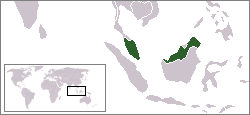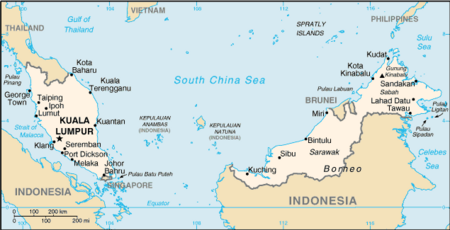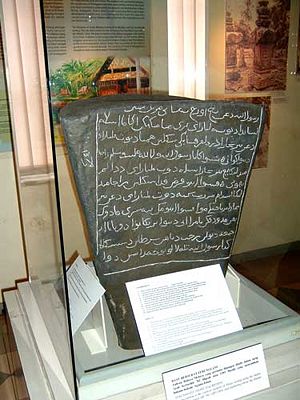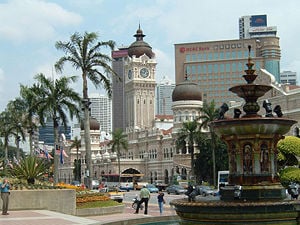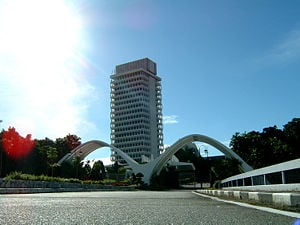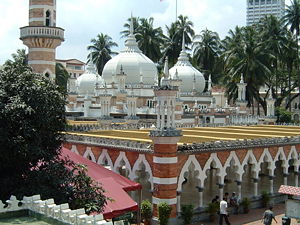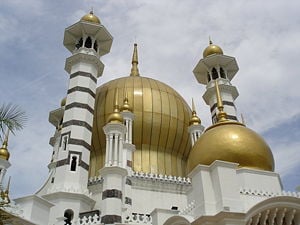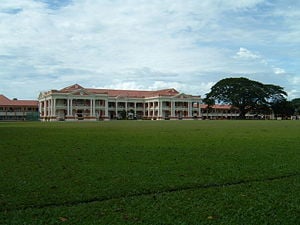Difference between revisions of "Malaysia" - New World Encyclopedia
Mike Butler (talk | contribs) m |
Mike Butler (talk | contribs) m |
||
| Line 66: | Line 66: | ||
The name "Malaysia" was adopted in 1963 when the [[Federation of Malaya]], [[Singapore]], [[Sabah]] and [[Sarawak]] formed a 14-state federation. Singapore was expelled in 1965 and subsequently became an independent country. | The name "Malaysia" was adopted in 1963 when the [[Federation of Malaya]], [[Singapore]], [[Sabah]] and [[Sarawak]] formed a 14-state federation. Singapore was expelled in 1965 and subsequently became an independent country. | ||
| − | Although politically dominated by the Malay people, modern Malaysian society is heterogeneous, with substantial Chinese and Indian minorities. | + | An off-shoot of Malay-Indonesian history, Malaysia has a rich culture that dates back to the third century B.C.E. Although politically dominated by the Malay people, modern Malaysian society is heterogeneous, with substantial Chinese and Indian minorities. |
==Geography== | ==Geography== | ||
| Line 109: | Line 109: | ||
From the tenth century the power of Srivijaya began to decline, weakened by a series of wars with the Javanese, which disrupted trade. In the eleventh century a rival power centre arose at Melayu, a port further up the Sumatran coast. The name is the origin of the word “Malay.” | From the tenth century the power of Srivijaya began to decline, weakened by a series of wars with the Javanese, which disrupted trade. In the eleventh century a rival power centre arose at Melayu, a port further up the Sumatran coast. The name is the origin of the word “Malay.” | ||
| − | The | + | [[Image:KlMuseumBatuBersurat.jpg|thumb|300px|The earliest record of a local law influenced by Islamic teaching and written in [[Jawi (script)|Jawi]]. The [[Terengganu Stone Monument|stone monument]] is found in [[Terengganu]].]] |
| + | The second phase began with the arrival of [[Islam]], which began in the tenth century, and led to the conversion of most of the Malay-Indonesian world and the breakup of the Srivijayan empire into many smaller sultanates. | ||
| + | According to the Kedah Annals, the ninth Maharaja Derbar Raja (1136-1179 C.E.) of the Sultanate of Kedah converted to Islam and changed his name to Sultan Muzaffar Shah. Since then Kedah has had 27 Sultans. | ||
| − | The | + | The port of [[Melaka]] (traditionally spelt Malacca) on the west coast of the [[Malay Peninsula]] was founded around 1400 by Parameswara, a rebel prince of the Srivijaya royal line. Expelled from Sumatera for killing the ruler of Temasek (now known as Singapore), Parameswara established himself in Melaka. It rapidly assumed the place previously held by Srivijaya, established independent relations with China, and dominated the straits to control the China-India maritime trade, which became increasingly important when the [[Mongol]] conquests closed the overland route between China and the west. Within a few years of its establishment, Melaka officially adopted Islam, and the Raja became a Sultan. |
| − | |||
| − | |||
| + | The political power of the [[Sultanate of Malacca|Malaccan Sultanate]] helped Islam’s rapid spread through the Malay world, reaching as far as the [[Philippines]] and leaving [[Bali]] as an isolated outpost of Hinduism. | ||
| + | Melaka’s reign lasted little more than a century, but it was of great importance, because it came to be seen as the golden age of Malay self-rule, and the Sultans of Melaka became the models for all subsequent Malay rulers. Melaka became a great cultural centre, creating the matrix of the modern Malay culture: a blend of indigenous Malay and imported Indian and Islamic elements. | ||
| + | The third phase was the intrusion into the area of the European colonial powers: first the [[Portugal|Portuguese]], who captured Melaka in 1511, then the [[Netherlands|Dutch]] and finally the [[United Kingdom|British]], who established bases at the island of [[Penang]], leased to the British East India Company, and [[Singapore]]. European domination led to the most fateful event in Malay history – the Anglo-Dutch treaty of 1824, which drew a frontier between British Malaya and the [[Netherlands East Indies]], which became Indonesia. At that time, the British took control of Malacca. This arbitrary division of the Malay world has proved permanent. | ||
| + | In 1826, Britain established the crown colony of the Straits Settlements, uniting its three possessions in Malaya: Penang, Malacca and Singapore. The Straits Settlements were administered under the East India Company in Calcutta until 1867, when they were transferred to the Colonial Office in London. On the island of [[Borneo]], Sabah was governed as the crown colony of British North Borneo, while Sarawak was acquired from [[Brunei]] as the personal kingdom of the Brooke family, who ruled as White Rajahs. | ||
| − | + | European domination also led to the fourth phase of foreign influence: the mass immigration of Chinese and Indian workers to meet the needs of the colonial economy created by the British in the Malay Peninsula and North Borneo. The Chinese and Indians posed a profound threat to the Malays, dominating economic life and the professions, and at one time threatening to make the Malays a minority in their own country. | |
| − | |||
| − | |||
| − | |||
[[Image:KualaLumpurAbdulSamadBldg.jpg|thumb|300px|[[Sultan Abdul Samad Building]] in Kuala Lumpur houses the [[High Court of Malaya]] and the Trade Court. Kuala Lumpur was the capital of the Federated Malay States and is the current Malaysian capital.]] | [[Image:KualaLumpurAbdulSamadBldg.jpg|thumb|300px|[[Sultan Abdul Samad Building]] in Kuala Lumpur houses the [[High Court of Malaya]] and the Trade Court. Kuala Lumpur was the capital of the Federated Malay States and is the current Malaysian capital.]] | ||
| Line 130: | Line 131: | ||
[[Image:Malaysia.JPG|thumb|300px|[[Kuala Lumpur]], the capital and largest city of Malaysia]] | [[Image:Malaysia.JPG|thumb|300px|[[Kuala Lumpur]], the capital and largest city of Malaysia]] | ||
| − | [[ | + | Following the Japanese occupation of Malaya (1942-1945) during [[World War II]], support for independence grew. Post-war British plans to unite the administration of Malaya under a single crown colony called the Malayan Union foundered on strong opposition from the ethnic Malays. The Malayan Union, established in 1946, was dissolved in 1948 and replaced by the Federation of Malaya, which restored the autonomy of the rulers of the Malay states under British protection. |
| − | + | Rebels under the leadership of the Communist Party of Malaya launched guerrilla operations designed to force the British out. The Malayan Emergency, as it was known, lasted from 1948 to 1960, and involved a long anti-insurgency campaign by Commonwealth troops in Malaya. Against this backdrop, independence for the Federation within the Commonwealth was granted on 31 August, 1957. | |
| − | |||
| − | |||
| − | |||
| − | |||
| − | |||
| − | |||
| − | |||
| − | |||
[[Image:Mmsia1.jpg|thumb|left|300px|Malaysia Day celebration in 1963. Majulah Malaysia means Forward Malaysia in Malay.]] | [[Image:Mmsia1.jpg|thumb|left|300px|Malaysia Day celebration in 1963. Majulah Malaysia means Forward Malaysia in Malay.]] | ||
| − | In 1963 the | + | In 1963, the federation was renamed Malaysia with the admission of the then-British crown colonies of [[Singapore]], [[Sabah]] (British North Borneo) and [[Sarawak]]. The Sultanate of [[Brunei]] withdrew. |
| − | |||
| − | |||
| − | The early years of independence were marred by conflict with Indonesia over the formation of Malaysia, Singapore's eventual exit in 1965, and racial strife in the form of May 13 racial riots in 1969. The [[Philippines]] also made | + | The early years of independence were marred by conflict with Indonesia over the formation of Malaysia, Singapore's eventual exit in 1965, and racial strife in the form of May 13 racial riots in 1969. The [[Philippines]] also made a claim on Sabah, which is still ongoing. |
| − | After the May 13 racial riots, Prime Minister Tun Abdul Razak launched the controversial New Economic Policy, which was intended to improve the economic position of the “Bumiputras” ( | + | After the May 13 racial riots, Prime Minister Tun Abdul Razak launched the controversial New Economic Policy, which was intended to improve the economic position of the “Bumiputras” (indigenous people). Malaysia has since maintained a delicate ethno-political balance, attempting to combine economic development with policies that favour Bumiputras. |
| − | Between the 1980s and the mid 1990s, Malaysia experienced significant economic growth | + | Between the 1980s and the mid 1990s, Malaysia experienced significant economic growth as a shift from an agriculture-based economy to one based on manufacturing of computers and consumer electronics occurred. The emergence of numerous mega-projects, including the Petronas Twin Towers, during this period, changed the physical landscape. |
In the late 1990s, the Asian financial crisis and political unrest caused by the sacking of the deputy prime minister Dato' Seri Anwar Ibrahim shook Malaysia. In 2003, Dr Mahathir, Malaysia's longest serving prime minister, retired in favour of his deputy, Abdullah Ahmad Badawi, commonly known as ''Pak Lah''. | In the late 1990s, the Asian financial crisis and political unrest caused by the sacking of the deputy prime minister Dato' Seri Anwar Ibrahim shook Malaysia. In 2003, Dr Mahathir, Malaysia's longest serving prime minister, retired in favour of his deputy, Abdullah Ahmad Badawi, commonly known as ''Pak Lah''. | ||
| Line 294: | Line 285: | ||
==References== | ==References== | ||
| − | |||
| − | |||
| − | |||
| − | |||
| − | |||
| − | |||
| − | |||
| − | |||
| − | |||
| − | |||
| − | |||
| − | |||
| − | |||
| − | |||
| − | + | Osborne, Milton, ''Southeast Asia: An Introductory History.'' Allen & Unwin, 2000. ISBN 1-86508-390-9 | |
| − | + | Farish Noor, ''From Majapahit to Putrajaya'', Silverfish Books, (2005). ISBN 983-3221-05-X | |
| − | + | M.C. Ricklefs, ''A History of Modern Indonesia,'' Indiana University Press, 1981. ISBN 0804721955 | |
| − | + | Goh, Cheng Teik,''Malaysia: Beyond Communal Politics'', Pelanduk Publications, (1994). ISBN 967-978-475-4. | |
| − | + | Musa, M. Bakri, ''The Malay Dilemma Revisited. Merantau Publishers'', 1999. ISBN 1-58348-367-5. | |
| − | + | Ye, Lin-Sheng, ''The Chinese Dilemma'',East West Publishing, 2003. ISBN 0-9751646-1-9. | |
| − | |||
| − | |||
| − | |||
| − | |||
| − | |||
| − | |||
==External links== | ==External links== | ||
| − | |||
| − | |||
| − | |||
| − | |||
| − | |||
| − | |||
| − | |||
| − | |||
| − | |||
| − | |||
| − | |||
| − | |||
| − | |||
| − | |||
| − | |||
| − | |||
| − | |||
| − | |||
| − | |||
| − | |||
| − | |||
| − | |||
| − | |||
| − | |||
| − | |||
| − | |||
| − | |||
| − | |||
| − | |||
| − | |||
| − | |||
| − | |||
| − | |||
| − | |||
| + | * [http://www.gov.my/ myGovernment Portal.html Malaysian Government Portal] ''Malaysian Government Portal'', observed January 26, 2007. | ||
| + | * [http://www.tourism.gov.my/ Tourism Malaysia.html - Malaysian tourism portal] ''Malaysian tourism portal'', observed January 26, 2007. | ||
| + | *[http://www.cia.gov/cia/publications/factbook/geos/th.html Malaysia] - ''CIA World Factbook - 2006'', observed January 26, 2007. | ||
| + | *[http://www.everyculture.com/Ja-Ma/index.html Malaysia] ''Countries and Their Cultures Ja-Ma, observed January 26, 2007. | ||
{{credit|99441445}} | {{credit|99441445}} | ||
Revision as of 04:55, 26 January 2007
| Malaysia مليسيا | |||||
| |||||
| Motto: Bersekutu Bertambah Mutu (English: "Unity Is Strength")[1] | |||||
| Anthem: "Negaraku" | |||||
| Capital | Kuala Lumpur1 3°08′N 101°42′E | ||||
|---|---|---|---|---|---|
| Largest city | Kuala Lumpur | ||||
| Official languages | Malay | ||||
| Government | Federal constitutional monarchy | ||||
| - Paramount Ruler | Sultan Mizan Zainal Abidin | ||||
| - Prime Minister | Abdullah Ahmad Badawi | ||||
| Independence | |||||
| - from the UK (Malaya only) | August 31 1957 | ||||
| - Federation (with Sabah, Sarawak and Singapore2) | September 16 1963 | ||||
| Area | |||||
| - Total | 329,847 km² (67th) 127,355 sq mi | ||||
| - Water (%) | 0.3 | ||||
| Population | |||||
| - Dec. 2006 estimate | 26,888,000 | ||||
| - 2000 census | 23,953,136 | ||||
| - Density | 82/km² 211/sq mi | ||||
| GDP (PPP) | 2006 estimate | ||||
| - Total | $290.7 billion | ||||
| - Per capita | $12,100 | ||||
| HDI (2006) | 0.805 (high) | ||||
| Currency | Ringgit (RM) (MYR)
| ||||
| Time zone | MST (UTC+8) | ||||
| - Summer (DST) | not observed (UTC+8) | ||||
| Internet TLD | .my | ||||
| Calling code | +60 | ||||
| 1 Putrajaya is the primary seat of government. 2 Singapore became an independent country on 9 August 1965. | |||||
Malaysia is a federation of 13 states in Southeast Asia. There are two distinct parts to Malaysia being peninsular Malaysia and east Malaysia.
The name "Malaysia" was adopted in 1963 when the Federation of Malaya, Singapore, Sabah and Sarawak formed a 14-state federation. Singapore was expelled in 1965 and subsequently became an independent country.
An off-shoot of Malay-Indonesian history, Malaysia has a rich culture that dates back to the third century B.C.E. Although politically dominated by the Malay people, modern Malaysian society is heterogeneous, with substantial Chinese and Indian minorities.
Geography
Peninsular Malaysia is located south of Thailand, north of Singapore and east of the Indonesian island of Sumatra. East Malaysia is located on the island of Borneo and shares borders with Brunei and Indonesia.
Peninsular Malaysia consists of nine sultanates (Johor, Kedah, Kelantan, Negeri Sembilan, Pahang, Perak, Perlis, Selangor and Terengganu), two states headed by governors (Malacca and Penang), and two federal territories (Putrajaya and Kuala Lumpur).
East Malaysia (or Malaysian Borneo) occupies the northern part of the island of Borneo, bordering Indonesia and surrounding the Sultanate of Brunei. It consists of the states of Sabah and Sarawak and the federal territory of Labuan.
At a total of 328,550 square kilometres, Malaysia is about the same size as New Mexico.
They share a largely similar landscape in that both feature coastal plains rising to often densely forested hills and mountains, the highest of which is Mount Kinabalu at 13,435.7 feet (4095.2 meters) on the island of Borneo.
The local climate is equatorial and characterised by the annual southwest (April to October) and northeast (October to February) monsoons.
Tanjung Piai, located in the southern state of Johor, is the southernmost tip of continental Asia. The Strait of Malacca, lying between Sumatra and Peninsular Malaysia, is arguably the most important shipping lane in the world.
Malaysia is well endowed with natural resources such as agriculture, forestry as well as minerals. In terms of agriculture, Malaysia is the world's primary exporter of natural rubber and palm oil, which together with sawn logs and sawn timber, cocoa, black pepper, pineapple and tobacco dominate the growth of the sector. Palm oil is also a major foreign exchange earner.
Today an estimated 59 percent of Malaysia remains forested. The rapid expansion of the timber industry since the 1960s has caused serious erosion. Subsequently, fewer trees are being felled, degraded forest areas are being replanted with rattan and fast-growing species such as meranti tembaga, merawan and sesenduk.
Rubber, once the mainstay of the Malaysian economy, has been largely replaced by oil palm as Malaysia's leading agricultural export.
Environment issues include air pollution from industrial and vehicular emissions, water pollution from raw sewage, deforestation, and smoke haze from Indonesian forest fires.
Putrajaya is the newly created administrative capital for the federal government of Malaysia, aimed in part to ease growing congestion within Malaysia's capital city, Kuala Lumpur, which remains the seat of parliament, as well as the commercial of the country. Other major cities include Georgetown, Ipoh, Johor Bahru, Kuching, Kota Kinabalu, Alor Star and Malacca Town.
History
The history of Malaysia is a relatively recent offshoot of the history of the wider Malay-Indonesian world. The Malay Peninsula has thrived from its central position in the maritime trade routes between China and the Middle East.
The history of the Malaysian area can be seen as four successive phases of outside influence, followed by the final assertion of Malay independence.
The first phase saw the domination of Hindu culture imported from India. In the third century B.C.E. Indian traders came to the archipelago both for its abundant forest and maritime products and to trade with merchants from China, who also discovered the Malay world at an early date. Both Hinduism and Buddhism were well established in the Malay Peninsula by the beginning of the first century C.E., and from there spread across the archipelago.
Chinese chronicles of the fifth century C.E. speak of a great port in the south called Guantoli, which was probably in the Strait of Malacca. In the seventh century, a new port called Shilifoshi is mentioned, and this is believed to be a Chinese rendering of Srivijaya.
For 700 years the Maharajahs of Srivijaya ruled a loose-knit maritime empire that controlled the coasts of Sumatra, Peninsular Malaya, and Borneo. Srivijaya lived by trade, welcoming annual trading fleets from China and India, and also traders from further afield. Its greatest enemies were the Siamese, in the north. To secure a powerful ally the maharajahs paid tribute to the Chinese Emperors.
From the tenth century the power of Srivijaya began to decline, weakened by a series of wars with the Javanese, which disrupted trade. In the eleventh century a rival power centre arose at Melayu, a port further up the Sumatran coast. The name is the origin of the word “Malay.”
The second phase began with the arrival of Islam, which began in the tenth century, and led to the conversion of most of the Malay-Indonesian world and the breakup of the Srivijayan empire into many smaller sultanates.
According to the Kedah Annals, the ninth Maharaja Derbar Raja (1136-1179 C.E.) of the Sultanate of Kedah converted to Islam and changed his name to Sultan Muzaffar Shah. Since then Kedah has had 27 Sultans.
The port of Melaka (traditionally spelt Malacca) on the west coast of the Malay Peninsula was founded around 1400 by Parameswara, a rebel prince of the Srivijaya royal line. Expelled from Sumatera for killing the ruler of Temasek (now known as Singapore), Parameswara established himself in Melaka. It rapidly assumed the place previously held by Srivijaya, established independent relations with China, and dominated the straits to control the China-India maritime trade, which became increasingly important when the Mongol conquests closed the overland route between China and the west. Within a few years of its establishment, Melaka officially adopted Islam, and the Raja became a Sultan.
The political power of the Malaccan Sultanate helped Islam’s rapid spread through the Malay world, reaching as far as the Philippines and leaving Bali as an isolated outpost of Hinduism.
Melaka’s reign lasted little more than a century, but it was of great importance, because it came to be seen as the golden age of Malay self-rule, and the Sultans of Melaka became the models for all subsequent Malay rulers. Melaka became a great cultural centre, creating the matrix of the modern Malay culture: a blend of indigenous Malay and imported Indian and Islamic elements.
The third phase was the intrusion into the area of the European colonial powers: first the Portuguese, who captured Melaka in 1511, then the Dutch and finally the British, who established bases at the island of Penang, leased to the British East India Company, and Singapore. European domination led to the most fateful event in Malay history – the Anglo-Dutch treaty of 1824, which drew a frontier between British Malaya and the Netherlands East Indies, which became Indonesia. At that time, the British took control of Malacca. This arbitrary division of the Malay world has proved permanent.
In 1826, Britain established the crown colony of the Straits Settlements, uniting its three possessions in Malaya: Penang, Malacca and Singapore. The Straits Settlements were administered under the East India Company in Calcutta until 1867, when they were transferred to the Colonial Office in London. On the island of Borneo, Sabah was governed as the crown colony of British North Borneo, while Sarawak was acquired from Brunei as the personal kingdom of the Brooke family, who ruled as White Rajahs.
European domination also led to the fourth phase of foreign influence: the mass immigration of Chinese and Indian workers to meet the needs of the colonial economy created by the British in the Malay Peninsula and North Borneo. The Chinese and Indians posed a profound threat to the Malays, dominating economic life and the professions, and at one time threatening to make the Malays a minority in their own country.
Following the Japanese occupation of Malaya (1942-1945) during World War II, support for independence grew. Post-war British plans to unite the administration of Malaya under a single crown colony called the Malayan Union foundered on strong opposition from the ethnic Malays. The Malayan Union, established in 1946, was dissolved in 1948 and replaced by the Federation of Malaya, which restored the autonomy of the rulers of the Malay states under British protection.
Rebels under the leadership of the Communist Party of Malaya launched guerrilla operations designed to force the British out. The Malayan Emergency, as it was known, lasted from 1948 to 1960, and involved a long anti-insurgency campaign by Commonwealth troops in Malaya. Against this backdrop, independence for the Federation within the Commonwealth was granted on 31 August, 1957.
In 1963, the federation was renamed Malaysia with the admission of the then-British crown colonies of Singapore, Sabah (British North Borneo) and Sarawak. The Sultanate of Brunei withdrew.
The early years of independence were marred by conflict with Indonesia over the formation of Malaysia, Singapore's eventual exit in 1965, and racial strife in the form of May 13 racial riots in 1969. The Philippines also made a claim on Sabah, which is still ongoing.
After the May 13 racial riots, Prime Minister Tun Abdul Razak launched the controversial New Economic Policy, which was intended to improve the economic position of the “Bumiputras” (indigenous people). Malaysia has since maintained a delicate ethno-political balance, attempting to combine economic development with policies that favour Bumiputras.
Between the 1980s and the mid 1990s, Malaysia experienced significant economic growth as a shift from an agriculture-based economy to one based on manufacturing of computers and consumer electronics occurred. The emergence of numerous mega-projects, including the Petronas Twin Towers, during this period, changed the physical landscape.
In the late 1990s, the Asian financial crisis and political unrest caused by the sacking of the deputy prime minister Dato' Seri Anwar Ibrahim shook Malaysia. In 2003, Dr Mahathir, Malaysia's longest serving prime minister, retired in favour of his deputy, Abdullah Ahmad Badawi, commonly known as Pak Lah.
Politics
Malaysia is a federal, constitutional, elective monarchy. The system of government is closely modelled on that of the Westminster parliamentary system, a legacy of British colonial rule. In practice however, more power is vested in the executive branch of government than in the legislature, and the judiciary has been weakened by sustained attacks by the government during the Mahathir era.
The federal head of state is the Yang di-Pertuan Agong, commonly referred to as the King of Malaysia, who is elected to a five-year term from among the nine hereditary Sultans of the Malay states. The other four states, which have titular governors, do not participate in the selection.
The leader of the party that wins a plurality of seats in the House of Representatives in legislative elections becomes prime minister.
Executive power is vested in the cabinet appointed and led by the prime minister with the consent of the head of state. The cabinet is chosen from among members of both houses of parliament and is responsible to that body.
The bicameral parliament consists of the Senate, or Dewan Negara (70 seats — 44 appointed by the paramount ruler, 26 appointed by the state legislatures), and the House of Representatives, or Dewan Rakyat (219 seats — members elected by popular vote to serve five-year terms)
The 219 members of the House of Representatives are elected from single-member constituencies that are drawn based on population for a maximum term of five years. All 70 senators sit for three-year terms; 26 are elected by the 13 state assemblies, two representing the federal territory of Kuala Lumpur, one each from federal territories of Labuan and Putrajaya, and 40 are appointed by the king.
Registered voters of age 21 and above may vote for the members of the House of Representatives and in most of the states, the state legislative chamber as well. Voting is not compulsory.
Since independence in 1957, Malaysia has been governed by a multi-party coalition known as the Barisan Nasional (formerly known as the Alliance), comprising a broadly representative group of 13 parties. There are five opposition parties.
Each state has a unicameral state legislative chamber or Dewan Undangan Negeri) whose members are elected from single-member constituencies. Chief ministers selected by the state assemblies lead the state governments and advise their respective sultans or governors.
The national holiday is Malaysia Day, 31 August, which marks independence attained in 1957. All Malaysians can celebrate Muslim, Chinese, Indian and Christian religious festivals.
The paramount ruler appoints judges to the Federal Court on the advice of the prime minister. The legal system is based on English common law. Legislative acts may be subject to judicial review in the Supreme Court at request of supreme head of the federation. Malaysia has not accepted compulsory International Court of Justice jurisdiction. Islamic law is applied to Muslims in matters of family law. Caning is a standard punishment for more than 40 crimes in Malaysia, ranging from sexual abuse to drug use. Administered with a thick rattan stick, it splits the skin and leaves scars.
Service in the Malaysian Armed Forces, comprising army, navy and airforce, is voluntary from age 18. About two percent of GDP is spent on the military.
Malaysia is involved in a sovereignty dispute over the Spratly Islands together with China, Philippines, Taiwan, Vietnam, and possibly Brunei. The dispute revolves around oil prospecting. There are disputes over deliveries of fresh water to Singapore, Singapore's land reclamation, bridge construction, and maritime boundaries. There are also disputes over the maritime boundary of Ligitan and Sipadan islands, in the hydrocarbon-rich Celebes Sea in dispute.
Separatist violence in Thailand's predominantly Muslim southern provinces prompts measures to close and monitor the border with Malaysia to stem terrorist activities. Malaysia's land boundary with Brunei around Limbang is in dispute. Piracy remains a problem in the Malacca Strait
Economy
Malaysia, a middle-income country, transformed itself from 1971 through the late 1990s from a producer of raw materials (Malaysia was once the world’s largest producer of tin) into an emerging multi-sector economy. Growth was almost exclusively driven by exports — particularly of electronics.
As a result, Malaysia was hard hit by the global economic downturn and the slump in the information technology sector in 2001 and 2002. GDP in 2001 grew only 0.5 percent because of an estimated 11 percent contraction in exports, but a substantial fiscal stimulus package equal to US$1.9-billion mitigated the worst of the recession, and the economy rebounded in 2002 with a 4.1 percent increase. The economy grew 4.9 percent in 2003, notwithstanding a difficult first half, when external pressures from Severe Acute Respiratory Syndrome (SARS) and the Iraq War led to caution in the business community. Growth topped 7 percent in 2004 and 5 percent per year in 2005-06.
As an oil and gas exporter, Malaysia has profited from higher world energy prices, although the rising cost of domestic gasoline and diesel fuel forced Kuala Lumpur to reduce government subsidies, contributing to higher inflation.
Malaysia "unpegged" the ringgit from the US dollar in 2005 and the currency appreciated 6 percent against the dollar in 2006. Healthy foreign exchange reserves and a small external debt greatly reduce the risk that Malaysia will experience a financial crisis over the near term similar to the one in 1997. The economy remains dependent on continued growth in the US, China, and Japan - top export destinations and key sources of foreign investment.
Other minerals of some importance or significance include copper, gold, bauxite, iron-ore and coal together with industrial minerals like clay, kaolin, silica, limestone, barite, phosphates and dimension stones such as granite as well as marble blocks and slabs. Small quantities of gold are produced.
Extensive roads connect all major cities and towns on the western coast of Peninsular Malaysia, while roads in the East Malaysia and the eastern coast of Peninsular Malaysia are still relatively undeveloped. Those are highly curved roads passing through mountainous regions and many are still unsealed, gravel roads. This has resulted in the continued use of rivers as the main mode of transportation for interior residents.
Malayan Railways has an extensive rail system connecting all cities and towns on the peninsular, including Singapore. There is also a short railway in Sabah operated by North Borneo Railway that mainly carries freight.
There are sea ports in Tanjong Kidurong, Kota Kinabalu, Kuching, Kuantan, Pasir Gudang, Tanjung Pelepas, Penang, Port Klang, Sandakan and Tawau. There are also world-class airports, such as Kuala Lumpur International Airport in Sepang, Bayan Lepas International Airport in Penang, Kuching International Airport and Langkawi International Airport that provide international and domestic destinations.
Exports totalled US$158.7-billion in 2006. Export commodities included electronic equipment, petroleum and liquefied natural gas, wood and wood products, palm oil, rubber, textiles, and chemicals. Export partners were the United States 19.7 percent, Singapore 15.6 percent, Japan 9.3 percent, China 6.6 percent, Hong Kong 5.8 percent, and Thailand 5.4 percent.
Imports totalled US$127.3-billion in 2006. Import commodities comprised electronics, machinery, petroleum products, plastics, vehicles, iron and steel products, and chemicals. Import partners were Japan 14.6 percent, the United States 13 percent, Singapore 11.8 percent, China 11.6 percent, Taiwan 5.6 percent, Thailand 5.3 percent, South Korea 5 percent, and Germany 4.5 percent.
Per capita GDP was US$12,700 in 2006.
Demographics
Malaysia's population of 26.8 million is comprised of many ethnic groups, with the politically dominant Malays making up the majority, 60 percent of the population. About 30 percent are Malaysians of Chinese descent, who have historically played an important role in trade and business. Indian Malaysians comprise about eight percent of the population, and 90 percent of these are Tamil people from southern India, living mainly in the larger towns on the west coast of the peninsula.
The largest non-Malay indigenous tribe is the Iban of Sarawak, who number over 600,000. Some Iban still live in traditional jungle villages in longhouses along the Rajang and Lupar rivers and their tributaries, although many have moved to the cities. The Bidayuh (170,000) are concentrated in the south-western part of Sarawak. The largest indigenous tribe in Sabah is the Kadazan. They are largely Christian subsistence farmers. The Orang Asli (140,000), or aboriginal peoples, comprise a number of different ethnic communities living in Peninsular Malaysia. Traditionally nomadic hunter-gatherers and agriculturists, many have been partly absorbed into modern Malaysia. They remain the poorest group in the country.
Other Malaysians also include those of European, Middle Eastern, Cambodian, and Vietnamese descent. Europeans and Eurasians include British who colonized and settled in Malaysia and some Portuguese, and most of the Middle Easterners are Arabs. A small number of Kampucheans and Vietnamese settled in Malaysia as Vietnam War refugees.
Due to the rise in labour-intensive industries, Malaysia has 10 percent to 20 percent foreign workers with the uncertainty due to the large number of illegal workers, mostly Indonesian.
Malaysia is a multi-religious society, and Islam is the country's official religion. The four main religions are Islam (60 percent of the population), Buddhism (19 percent), Christianity (9.1 percent, mostly in Sabah and Sarawak), and Hinduism (6.3 percent), according to the 2004 census. The Chinese population is mostly Buddhist (of Mahayana sect), Taoist or Christian. Until the twentieth century, most practiced traditional beliefs, which still linger on. All Malay persons are officially regarded and treated as Muslim, regardless of private belief.
Although the Malaysian constitution theoretically guarantees religious freedom, in practice the situation is not so simple. Non-Muslims often experience restrictions in the construction of religious buildings and the celebration of religious events. Muslims are obliged to follow the decisions of sharia courts. As a legal matter, it is not yet clear whether Muslims may freely leave Islam. In some situations, the Malaysian courts have denied one's right to freedom of religion even when one has renounced Islam (such as the Joshua Jamaluddin versus the Minister of Home Affairs case in the 1980s). Generally one who wishes to leave Islam makes a legal declaration, but this is still not recognised by the Malaysian civil courts. One is said to have to obtain a declaration of apostasy with a Sharia Court, but the court will not grant one.
All Malaysians are federal citizens except for those living in East Malaysia where state citizenship distinguishable from peninsular citizenship. Every citizen is issued with a biometric smart chip identity card, known as MyKad, at the age of 12, and must carry the card with them.
Industrialisation has resulted in legions of women workers on assembly lines. At home, cooking and cleaning is still deemed to be female responsibilities. Wealthier families hire domestic servants, mainly female foreign maids.
Marriage practices reveal Malaysia's religious fault lines. In that country, Christians may marry Buddhists or Hindus answering only to their families and beliefs. Muslims who marry non-Muslims risk government sanction unless their partner converts to Islam. Indians and Chinese turn to divination to establish compatibility and auspicious dates, while Malays have elaborate gift exchanges. Malay wedding feasts are often held in the home, and feature a large banquet with several dishes eaten over rice prepared in oil. Many Chinese weddings feature a multiple-course meal in a restaurant or public hall, and most Indian ceremonies include intricate rituals.
Industrialization has made it difficult for extended families to live together. But better telecommunications keep distant kin in contact, as does the efficient transportation network. Among the majority of Malays, siblings are more important than ancestors.
Land ownership is a controversial issue. After the rubber boom the British colonial government, to placate Malays, designated areas as Malay reservations. This land could only be sold to other Malays, limiting planters and speculators. Land disputes could only be settled with a legal definition of who was considered Malay. These land tenure arrangements are still in effect. The Malay claim to political dominance is that they are “bumiputera” (sons of the soil).
Malay became Malaysia's sole national language in 1967. The Austronesian language has been a lingua franca throughout the region, though English is also widely spoken because it was the administrative language of the British colonizers, and Rapid industrialization has sustained its importance and solidified it as the language of business. Chinese speak a variety of Chinese dialects including Mandarin Chinese, Hokkien/Fujian, Cantonese, Hakka and Teochew. Most Indian Malaysians speak Tamil, Telugu, Malayalam, and Hindi.
Numerous languages flourish among indigenous groups, especially in Sarawak and Sabah. A small number of Eurasians, of mixed Portuguese and Malay descent, speak a Portuguese-based creole, called Kristang language. Eurasians of mixed Malay and Spanish descent, mostly in Sabah, who descended from immigrants from the Philippines, speak Chavacano, the only Spanish-based creole language in Asia.
Television news is broadcast in Malay, English, Mandarin, and Tamil. Malaysians are adept at learning languages, and knowing multiple languages is common.
Class position is based on political connections, specialized skills, ability in English, and family money. The Malaysian elite, trained in overseas universities, continues to grow in dominance as Malaysia's middle class expands. A mobile phone, gold jewelry, and fashionable clothing all indicate high rank in the social order. One's vehicle marks class position more than home ownership. Skin color, indicating time working in the hot tropical sun, further marks class position. Knowledge of English is vital to elevated class status.
Culture
Within Malaysia there is a Malay culture, a Chinese culture, an Indian culture, a Eurasian culture, along with the cultures of the indigenous groups of the peninsula and north Borneo.
Malaysia has one of the most exquisite cuisines in the world. Elements of Malay, Chinese, and Indian cooking are both distinct and blended together. Rice and noodles are common to all cuisine; spicy dishes are also favorites. Tropical fruits are abundant, and a local favorite is the durian, known by its spiked shell and fermented flesh. Increasing amounts of meat and processed foods supplement the country's diet, prompting concerns about the health risks of their high-fat content. Increased affluence allows Malaysians to eat out more often — small hawker stalls offer prepared food 24 hours a day in urban areas. Muslims are forbidden to eat pork that is favoured by the Chinese population; Hindus do not eat beef, while some Buddhists are vegetarian.
In the past, Malay was written widely in Jawi script, a script based on Arabic. Over time, romanized script overtook Jawi as the dominant script. This was largely due to the influence of the colonial education system that taught children in romanized writing.
Most Malaysian children start schooling between the ages of three to six, in kindergarten. Most kindergartens run privately, as well as some government-operated kindergartens.
Children begin primary schooling at age of seven for six years. There are two major types of state primary schools: national schools (Sekolah Kebangsaan) which use Malay as medium of instruction, and national-type schools (Sekolah Jenis Kebangsaan) which use either Chinese or Tamil. Students in year six sit for the primary school assessment examination.
Education in government secondary schools lasts five years, and is conducted in Malay, apart from language, mathematics and science subjects. At the end of the third year or form three, students sit for the lower secondary assessment. In the last year (form five), students sit for the Malaysian Certificate of Education, which is equivalent to the British Ordinary or 'O' Levels, now referred to as GCSE.
Mathematics and science subjects in government primary and secondary schools such as biology, physics, chemistry are taught in English, so that students would not be hindered by any language barrier during tertiary education.
There are also 60 Chinese Independent High Schools in Malaysia, where most subjects are instructed in Chinese. Studying in independent schools takes six years to complete, divided into junior middle (three years) and senior middle (three years). Students sit for a standardised test known as the Unified Examination Certificate (UEC) in junior middle (equivalent to PMR) and senior middle (equivalent to AO level).
Students wishing to enter public universities must complete a further 18 months of secondary schooling in form six and sit for the Malaysia Higher Certificate of Education; equivalent to the British Advanced or “A” levels.
As for tertiary education, there are public universities such as University of Malaya and Universiti Kebangsaan Malaysia. In addition, five international reputable universities have set up their branch campuses in Malaysia since 1998.
Students can also opt to go to private colleges after secondary studies. Most colleges have educational links with overseas universities especially in the United States, the United Kingdom and Australia. Malaysian students abroad study mostly in the UK, United States, Australia, Singapore, South Korea, Japan, Canada and New Zealand.
Malaysia has many international schools that offer students the opportunity to study the curriculum of another country. These include the Australian International School, Malaysia (Australian curriculum), and The International School of Kuala Lumpur (International Baccalaureate and American curriculum).
Malaysian traditional music is heavily influenced by Chinese and Islamic forms. The music is based largely around the gendang (drum), but includes other percussion instruments (some made of shells); the rebab, a bowed string instrument; the serunai, a double-reed oboe-like instrument; flutes, and trumpets. The country has a strong tradition of dance and dance dramas, some of Thai, Indian and Portuguese origin. Other artistic forms include wayang kulit (shadow puppet theatre), silat (a stylised martial art) and crafts such as batik, weaving, and silver and brasswork.
Malaysia's pop music scene developed from traditional asli (pure) music popularized in the 1920s and 1930s by Bangsawan troupes. In the 1960s, western-influenced Pop Yeh-yeh musicians came to the forefront, following the music and fashion of The Beatles and other British rock and roll bands. "Kugiran" six-piece bands, that comprise a vocalist, one lead-guitarist, one bassist, one rhythm-guitarist, one organist (keyboardist)and a drummer, in the 1960s, encouraged the establishment and existence of various recording companies in Singapore in the 1960s.
Between the late 1970s and mid 1980s, the market for local recordings and artists was in big demand, bands and musicians performing in clubs and pubs were contracted to record. This was the time when non-Malay artistes, bands and business man ventured into the Malay music industry. By the mid 1980s, rock, heavy metal, hard rock and the blues bands appeared influenced by western bands Led Zeppelin, Deep Purple, and Def Leppard.
Between the late 80s and early 90s, R&B and Pop music became the focus of the urban youngsters. This music was cosmopolitan and catered to a professional and educated crowd. In the mid 1990s, KRU a vocal group comprised of three brothers developed Malay rap and hip-hop. Islam-influenced pop appeared in 1991. Guitar-driven bands with inclination towards heavy metal, thrash metal, speed metal and death metal, along with hip-hop, electronica and dance music, populate the Malaysian alternative music scene.
The encouragement from the Malaysian government towards privatization of broadcasting stations led to an array of new radio and TV stations to cover entertainment, news, movies and information. Reality shows such as Akademi Fantasia and Malaysian Idol allowed the public to choose their own stars by sending votes through hand phones or computers.
ReferencesISBN links support NWE through referral fees
Osborne, Milton, Southeast Asia: An Introductory History. Allen & Unwin, 2000. ISBN 1-86508-390-9
Farish Noor, From Majapahit to Putrajaya, Silverfish Books, (2005). ISBN 983-3221-05-X
M.C. Ricklefs, A History of Modern Indonesia, Indiana University Press, 1981. ISBN 0804721955
Goh, Cheng Teik,Malaysia: Beyond Communal Politics, Pelanduk Publications, (1994). ISBN 967-978-475-4.
Musa, M. Bakri, The Malay Dilemma Revisited. Merantau Publishers, 1999. ISBN 1-58348-367-5.
Ye, Lin-Sheng, The Chinese Dilemma,East West Publishing, 2003. ISBN 0-9751646-1-9.
External links
- myGovernment Portal.html Malaysian Government Portal Malaysian Government Portal, observed January 26, 2007.
- Tourism Malaysia.html - Malaysian tourism portal Malaysian tourism portal, observed January 26, 2007.
- Malaysia - CIA World Factbook - 2006, observed January 26, 2007.
- Malaysia Countries and Their Cultures Ja-Ma, observed January 26, 2007.
Credits
New World Encyclopedia writers and editors rewrote and completed the Wikipedia article in accordance with New World Encyclopedia standards. This article abides by terms of the Creative Commons CC-by-sa 3.0 License (CC-by-sa), which may be used and disseminated with proper attribution. Credit is due under the terms of this license that can reference both the New World Encyclopedia contributors and the selfless volunteer contributors of the Wikimedia Foundation. To cite this article click here for a list of acceptable citing formats.The history of earlier contributions by wikipedians is accessible to researchers here:
The history of this article since it was imported to New World Encyclopedia:
Note: Some restrictions may apply to use of individual images which are separately licensed.
- ↑ Malaysian Flag and Crest. myGovernment. Extracted September 13 2006.


